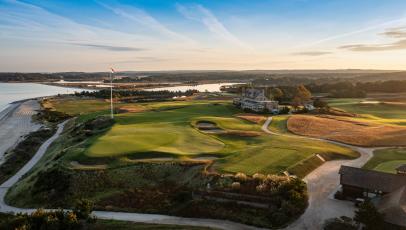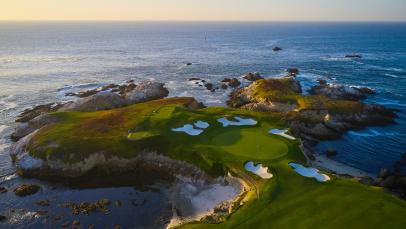Course News
Cabot is set to revive an early Bill Coore solo design in France

The Chateaux course's second hole at the rebranded Cabot Bordeaux in France, designed by Bill Coore in the late 1980s.
When The Cabot Collection announced in 2022 that it had acquired Castle Stuart in Inverness, Scotland, rebranded Cabot Highlands with a second course by Tom Doak now under construction, it was the luxury resort developer’s first venture into Europe. Cabot has now purchased the Golf du Médoc in Bordeaux, France, marking an expansion into the continent.
Golf du Médoc, now called Cabot Bordeaux, joins a growing portfolio of The Cabot Collection properties that includes (in addition to Cabot Highlands) Cabot Cape Breton, Cabot Saint Lucia, Cabot Revelstoke in British Columbia (where an 18-hole course by Rod Whitman is under construction) and Cabot Citrus Farms in Florida, with the 18-hole Karoo course currently open for preview play and the 18-hole Roost course, which will open for preview play in October (in addition to the nine-hole Squeeze course and 11-hole short course called The Wedge).
The Cabot Bordeaux property consists of two 18-hole courses, the Chateaux, designed by Bill Coore (opened in 1989), and the Vignes by Whitman (1991). The resort also offers a soon-to-be-renovated 79-room hotel, restaurant, spa and other amenities, as well as the Bernard Pascassio golf training center.
Pascassio, a former French professional player and golf television commentator, was instrumental in the creation of Golf du Médoc in the mid-1980s. Pascassio met Coore, who was based in Texas, through a mutual acquaintance and connected him with the developers who wanted to build a golf club in Bordeaux. Coore had just formed his design partnership with Ben Crenshaw, but the two had no projects at the time.

Cabot Bordeaux's Chateaux course.
“Well, business was frankly not going very well, and I needed something to do,” Coore says. “Ben wasn’t going to start working in France because he was playing a full schedule on the PGA Tour, so that’s when I started talking to my friend Rod Whitman about helping me build this golf course in France. And he said, ‘Yeah, I’ll do it.’ ”
For the developers to hire him at that unproven point in time and without the Crenshaw name to boost visibility was, as Coore puts it, “a monstrous leap of faith.”
During his first visit to the future Chateaux course site with Pascassio, the land was covered in snow, a rare occurrence in Bordeaux.
“Bernard says, ‘I know you love sand, and this site is all sand—all sand!’,” Coore remembers. “He led me over to this tall pile of something covered in snow, and he scrapes it off with his hands and starts digging into it, and sure enough he’s coming out with these handfuls of sand. He says, ‘See, sand. It’s perfect for you!’ ”
Coore returned to the U.S. excited about the prospects of constructing a new course in sand, even though the site had little topography to work with. The next spring he and Whitman flew to back to Bordeaux for preliminary work.
“So, Rod and I are standing there looking over the site, which was basically a dead flat site,” Coore says, “and it was under water. There was about six inches of water over the entire site. They had given us these Wellington boots to walk around in, and we’re tramping through it, and Rod looks at me and says, ‘It’s a god damned swamp! What have you gotten me into?’ ”
“I said, ‘It was dry the last time I saw it!’ And he says, ‘That’s because it was winter and the water was frozen!’”
Coore, Whitman and the team managed to drain the site by digging burns and channels that now snake through the property and come into play on several holes, including the par-5 14th where one runs down the left edge and bows in front of the green.

The 11,000-square-foot green at the Chateaux course's 18th hole.
Though constructed on a shoestring budget using local crews that had little if any experience building golf holes, Coore’s goal was to create a course with a simple, old-world feel, something inspired by the courses of the English heathlands. Laborers pushed the earth around to replicate natural ground movements, and stumps and bushes harvested during clearing were piled on the perimeters of the holes and buried in sand to make grass-covered berms and dunes-like mounds. Yellow-flowering genet bushes added contrast to the composition.
The bunkering, notched into landforms with edges that blur into roughs and clumps of genet, appeared to have been built decades before and were prototypes of the style of naturalistic bunkers Coore and Crenshaw and their shapers would later perfect at acclaimed courses like Sand Hills, Bandon Trails and Old Sandwich. The greens, which vary in size from just 6,000-square-feet to over 13,000, featured lovely rolls and slopes that bleed off the edges.
“The end result, if I can say so, was pretty darn good,” Coore says. “The experiences gained there certainly carried forward to a lot of the courses that Ben and I have built in the years since then.”
In an early review shortly after the course opened, a French writer claimed, ‘there’s a new Tom Simpson in the country.’”
“I’ll take that compliment,” says Coore, who has previously cited the influence of Simpson’s writings and sketches on his own thinking.

Holes like the sinewy 14th at Rod Whitman's Vineyard Trail course delve into the forests of the Medoc.
Several years later, Whitman was brought back to design and build the second course. Vineyard Trail possesses much of the same DNA as the Chateaux course, though it’s tighter off the tee and plays deeper into the countryside of pine forests with generally smaller greens. If Coore’s course is broader and more heathland, Whitman’s is sinewy and target-focused.
There are no plans for major remodels of either course—the essential elements of intriguing golf are in place and will come out with the kind of burnishing Cabot can provide. Coore is happy to see that his and Whitman’s courses, built at critical junctures in each of their careers, will get renewed life as they head into middle age.
“It has a very special place in my heart and was a very positive experience for me personally,” he says.
“I remember going there with Rod a number of years after his course opened. They were driving us to the club and it was raining, a light rain, and as we pulled into the gate we could see the two courses through the pines and the genet bushes were in bloom and there were people playing and walking on both courses with their brightly colored umbrellas bobbing along. We asked the driver to pull over and stop the car. Rod and I just looked at each other and said, this is unbelievable. It could have been a scene from the U.K., and it almost looked like a Harry Rountree painting. We just thought, can you imagine?”
• • •
Explore Golf Digest's new Course Reviews section where you can submit a star rating and evaluation on all the courses you’ve played. We've collected tens of thousands of reviews from our course-ranking panelists to deliver a premium experience, which includes course rankings, experts' opinions, bonus course photography, videos and much more. Check it out here!




